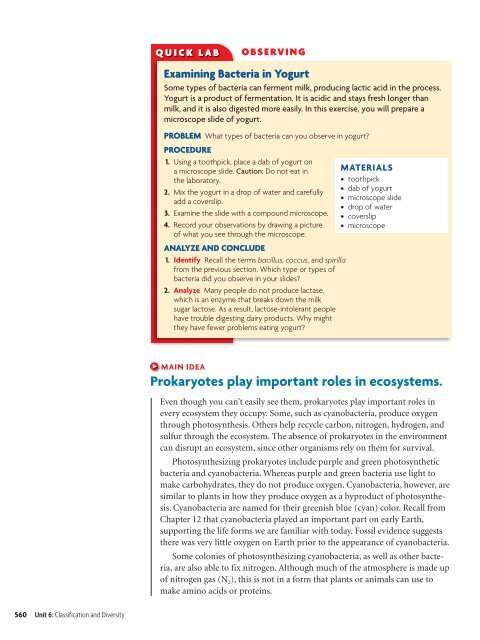18.1 Studying Viruses and Prokaryotes
18.1 Studying Viruses and Prokaryotes
18.1 Studying Viruses and Prokaryotes
You also want an ePaper? Increase the reach of your titles
YUMPU automatically turns print PDFs into web optimized ePapers that Google loves.
QUICK LABOBSERVINGExamining Bacteria in YogurtSome types of bacteria can ferment milk, producing lactic acid in the process.Yogurt is a product of fermentation. It is acidic <strong>and</strong> stays fresh longer thanmilk, <strong>and</strong> it is also digested more easily. In this exercise, you will prepare amicroscope slide of yogurt.PROBLEM What types of bacteria can you observe in yogurt?PROCEDURE1. Using a toothpick, place a dab of yogurt ona microscope slide. Caution: Do not eat inthe laboratory.2. Mix the yogurt in a drop of water <strong>and</strong> carefullyadd a coverslip.3. Examine the slide with a compound microscope.4. Record your observations by drawing a pictureof what you see through the microscope.ANALYZE AND CONCLUDE1. Identify Recall the terms bacillus, coccus, <strong>and</strong> spirillafrom the previous section. Which type or types ofbacteria did you observe in your slides?2. Analyze Many people do not produce lactase,which is an enzyme that breaks down the milksugar lactose. As a result, lactose-intolerant peoplehave trouble digesting dairy products. Why mightthey have fewer problems eating yogurt?MATERIALS• toothpick• dab of yogurt• microscope slide• drop of water• coverslip• microscopeMAIN IDEA<strong>Prokaryotes</strong> play important roles in ecosystems.Even though you can’t easily see them, prokaryotes play important roles inevery ecosystem they occupy. Some, such as cyanobacteria, produce oxygenthrough photosynthesis. Others help recycle carbon, nitrogen, hydrogen, <strong>and</strong>sulfur through the ecosystem. The absence of prokaryotes in the environmentcan disrupt an ecosystem, since other organisms rely on them for survival.Photosynthesizing prokaryotes include purple <strong>and</strong> green photosyntheticbacteria <strong>and</strong> cyanobacteria. Whereas purple <strong>and</strong> green bacteria use light tomake carbohydrates, they do not produce oxygen. Cyanobacteria, however, aresimilar to plants in how they produce oxygen as a byproduct of photosynthesis.Cyanobacteria are named for their greenish blue (cyan) color. Recall fromChapter 12 that cyanobacteria played an important part on early Earth,supporting the life forms we are familiar with today. Fossil evidence suggeststhere was very little oxygen on Earth prior to the appearance of cyanobacteria.Some colonies of photosynthesizing cyanobacteria, as well as other bacteria,are also able to fix nitrogen. Although much of the atmosphere is made upof nitrogen gas (N 2 ), this is not in a form that plants or animals can use tomake amino acids or proteins.560 Unit 6: Classification <strong>and</strong> Diversity
















